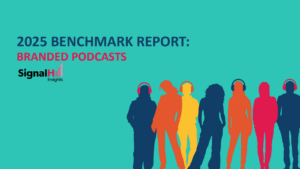 Podcast / audio research and intelligence company Signal Hill Insights released its 2025 Benchmark Report: Branded Podcasts. It seeks to describe the why, the how, and the payoffs of creating a branded podcast, while offering Signal Hill’s measurement service.
Podcast / audio research and intelligence company Signal Hill Insights released its 2025 Benchmark Report: Branded Podcasts. It seeks to describe the why, the how, and the payoffs of creating a branded podcast, while offering Signal Hill’s measurement service.
The information in this report was derived by a meticulous process that seems labor intensive both for the surveyor and the surveyed. The survey field totaled hundreds, not thousands that we often see in other studies. The tradeoff is numbers for depth — the recruited podcast listeners were given whole branded podcasts for listening. The survey asked what they liked, what they didn’t, whether they would recommend it, and whether they would isten to more episodes.
The study protocol also asked about brand metrics like awareness, affinity to the brand, and consideration of getting involved with the brand. Interestingly and valuably, all survey questions were open questions, resulting in granular evaluations like, “[The podcast] included details of specific individuals that I was unaware of. I found that to be an interesting expansion of the events.”
Golden Rules
Skipping to the end of Signal Hill’s 18-page deck, we see three emphasized takeaways for brands contemplating a podcast:
- Interest
- Relevancy
- Entertainment
The principles demand knowledge of the audience. For that, we get another bullet list for companies planning a podcast strategy:
- Define the audience
- Learn about the audience
- Understand the audience motivations for listening

And above all: “Measure your podcast to see if you’re doing it right, and learn how to do it even right-er.”
That principle leads to the marketing point of this exercise, which is Signal Hill’s explanation of how the company measures podcasts. The approach involves recruiting hundreds of listeners, giving them whole episodes, surveying their reactions, and measuring lift in brand awareness, affinity, and consideration. All this is measured against another survey cohort that did not hear the sample podcast.
The presentation offers many examples of survey responses, and culls key learnings such as: “A podcast doesn’t need to be lighthearted or funny to be entertaining.”
There is much more here than our skim, and the deck offers contact information. Direct download via PDF is HERE.

